Research on Yaw Stability Control of Front-Wheel Dual-Motor-Driven Driverless Formula Racing Car
Abstract
:1. Introduction
2. Control Principle
3. Two-Degree-of-Freedom Vehicle Reference Model
4. Yaw Moment Controller
4.1. Integral Sliding Mode Yaw Moment Controller
4.2. Torque Distribution Controller
4.2.1. Optimized Target Design
4.2.2. Torque Distribution Rules
5. Simulation and Result Analysis
5.1. Double-Lane-Change (DLC) Simulation
5.2. Autocross Traction Simulation
6. Conclusions
- Taking the yaw stability of the racing car as the control objective, the upper layer is designed based on integral sliding mode theory, which solves the jitter problem of the traditional sliding mode control by introducing an integral term based on the original sliding mode control principle. The linear two-degree-of-freedom model of the racing car is established to calculate the expected yaw angular velocity, the expected side slip angle, and the additional yaw moment.
- Aiming at the additional torque generated when the racing car turns, the lower torque distribution controller is designed, and the torque optimization goal and torque distribution rules of the car are used as the evaluation criteria to optimize the torque distribution of the two motors of the inner and outer wheels.
- The results of simulation experiments under two different working conditions show that the yaw stability of the driverless formula racing car with the yaw stability control strategy proposed in this paper is significantly improved when traveling and turning under different road conditions, which verifies the effectiveness of the yaw stability control strategy proposed in this paper. It improves the yaw stability of the car when turning at high speed and driving on low-adhesion-coefficient roads.
Author Contributions
Funding
Data Availability Statement
Conflicts of Interest
References
- Hu, J. Rules for China University Student Driverless Formula Competition. Available online: http://www.formulastudent.com.cn/news/5770.html (accessed on 18 April 2024).
- Zhang, Z.; Li, G.; Li, N. Research on cooperative control strategy of FSAC racing car trajectory tracking. J. Automot. Eng. 2023, 13, 750–759. [Google Scholar] [CrossRef]
- Li, X.; Yin, G.; Ren, Y.; Wang, F.; Fang, R.; Li, A. Hierarchical Control for Distributed Drive Electric Vehicles Considering Handling Stability and Energy Efficiency. In Proceedings of the 2023 IEEE International Automated Vehicle Validation Conference (IAVVC), Austin, TX, USA, 16–18 October 2023; pp. 1–6. [Google Scholar] [CrossRef]
- Feng, Y.; Zhang, B.; Zhang, R.; Shi, P.; Wang, Z.; Zhou, C. Estimations of vehicle driving state and road friction coefficient based on High-degree cubature Kalman filter of distributed drive electric vehicles. In Proceedings of the 2021 5th CAA International Conference on Vehicular Control and Intelligence (CVCI), Tianjin, China, 29–31 October 2021; pp. 1–6. [Google Scholar] [CrossRef]
- Yu, C.; Zheng, Y.; Shyrokau, B.; Ivanov, V. MPC-based Path Following Design for Automated Vehicles with Rear Wheel Steering. In Proceedings of the 2021 IEEE International Conference on Mechatronics (ICM), Kashiwa, Japan, 7–9 March 2021; pp. 1–6. [Google Scholar] [CrossRef]
- Mutoh, N.; Saitoh, T.; Sasaki, Y. Driving Force Control Method to Perform Slip Control in Cooperation with the Front and Rear Wheels for Front-and-Rear Wheel-Independent-Drive-Type EVs (FRID EVs). In Proceedings of the 2008 11th International IEEE Conference on Intelligent Transportation Systems, Beijing, China, 12–15 October 2008; pp. 925–930. [Google Scholar] [CrossRef]
- Woo, S. Active Differential Control for Improved Handling Performance of Front-Wheel-Drive High-Performance Vehicles. Int. J. Automot. Technol. 2021, 22, 537–546. [Google Scholar] [CrossRef]
- Liang, Z.; Shen, M.; Zhao, J.; Li, Z.; Wang, Y.; Ding, Z. Adaptive Sliding Mode Fault Tolerant Control for Autonomous Vehicle With Unknown Actuator Parameters and Saturated Tire Force Based on the Center of Percussion. IEEE Trans. Intell. Transp. Syst. 2023, 24, 11595–11606. [Google Scholar] [CrossRef]
- Sakhnevych, A.; Arricale, V.M.; Bruschetta, M.; Censi, A.; Mion, E.; Picotti, E.; Frazzoli, E. Investigation on the Model-Based Control Performance in Vehicle Safety Critical Scenarios with Varying Tyre Limits. Sensors 2021, 21, 5372. [Google Scholar] [CrossRef] [PubMed]
- Song, Y.; Shu, H.; Chen, X.; Luo, S. Direct-yaw-moment control of four-wheel-drive electrical vehicle based on lateral tyre–road forces and sideslip angle observer. IET Intell. Transp. Syst. 2019, 13, 303–312. [Google Scholar] [CrossRef]
- Liu, Z.; Qiao, Y.; Chen, X. A Novel Control Strategy of Straight-line Driving Stability for 4WID Electric Vehicles Based on Sliding Mode Control. In Proceedings of the 2021 5th CAA International Conference on Vehicular Control and Intelligence (CVCI), Tianjin, China, 29–31 October 2021; pp. 1–6. [Google Scholar] [CrossRef]
- Li, Z.; Wang, P.; Chen, H. Coordinated longitudinal and lateral vehicle stability control based on the combined-slip tire model in the MPC framework. In Proceedings of the 2020 Chinese Control And Decision Conference (CCDC), Hefei, China, 22–24 August 2020; pp. 103–105. [Google Scholar] [CrossRef]
- Chu, L.; Chen, J.; Yao, L.; Chao, L.; Zhang, Y.; Liu, M.; Zhao, Z. Vehicle stability control algorithm based on optimal fuzzy theory. In Proceedings of the 2011 International Conference on Electronic & Mechanical Engineering and Information Technology, Harbin, China, 12–14 August 2011; pp. 3210–3213. [Google Scholar] [CrossRef]
- Li, Q.; Li, J.; Wang, S.; Zhang, X.; Liu, J. Four Wheel Steering Vehicles Stability Control Based on Adaptive Radial Basis Function Neural Network. In Proceedings of the 2021 33rd Chinese Control and Decision Conference (CCDC), Kunming, China, 22–24 May 2021; pp. 1140–1145. [Google Scholar] [CrossRef]
- Saikia, A.; Mahanta, C. Vehicle stability enhancement using sliding mode based active front steering and direct yaw moment control. In Proceedings of the 2017 Indian Control Conference (ICC), Guwahati, India, 4–6 January 2017; pp. 378–384. [Google Scholar] [CrossRef]
- Cai, L.; Liao, Z.; Wei, S.; Li, J. Improvement of Maneuverability and Stability for Eight wheel Independently Driven Electric Vehicles by Direct Yaw Moment Control. In Proceedings of the IEEE 2021 24th International Conference on Electrical Machines and Systems (ICEMS), Gyeongju, Republic of Korea, 31 October 2021–3 November 2021. [Google Scholar] [CrossRef]
- Zhou, H.; Chen, H.; Ren, B.; Zhao, H. Yaw stability control for in-wheel-motored electric vehicle with a fuzzy PID method. In Proceedings of the 27th Chinese Control and Decision Conference (2015 CCDC), Qingdao, China, 23–25 May 2015; pp. 1876–1881. [Google Scholar] [CrossRef]
- Kong, D.; Liu, C.; Cui, M.; Lv, Y.; Liu, K.; Guo, H. Yaw Stability Control of Distributed Drive Electric Vehicle Based on Torque Optimal Distribution in Ice and Snow Environment. In Proceedings of the IEEE 2022 6th CAA International Conference on Vehicular Control and Intelligence (CVCI), Nanjing, China, 28–30 October 2022. [Google Scholar] [CrossRef]
- Wang, S.; Zhang, J. The research and application of fuzzy control in four-wheel-steering vehicle. In Proceedings of the 2010 Seventh International Conference on Fuzzy Systems and Knowledge Discovery, Yantai, China, 10–12 August 2010; Volume 3, pp. 1397–1401. [Google Scholar] [CrossRef]
- Zhang, H.; Xu, D.; Li, Y.; Hu, X. Fuzzy neural network simulation of vehicle yaw rate control based on PID. In Proceedings of the 2020 3rd World Conference on Mechanical Engineering and Intelligent Manufacturing (WCMEIM), Shanghai, China, 4–6 December 2020; pp. 430–434. [Google Scholar] [CrossRef]
- Li, Y.; Huang, P.; Xie, T. A Research on Adaptive Neural Network Control Strategy of Vehicle Yaw Stability. In Proceedings of the 2013 Fourth International Conference on Intelligent Systems Design and Engineering Applications, Zhangjiajie, China, 6–7 November 2013; pp. 48–51. [Google Scholar] [CrossRef]
- Bhoi, S.C.; Swain, S.K. Sliding Mode Based Robust Lateral Control for Autonomous Vehicles. In Proceedings of the 2021 International Symposium of Asian Control Association on Intelligent Robotics and Industrial Automation (IRIA), Goa, India, 20–22 September 2021; pp. 222–227. [Google Scholar] [CrossRef]
- Saepulah, F.; Santoso, A. Electric Vehicle Lateral Stability Control Design Based on Brake-By-Wire System Using Fuzzy-SMC. In Proceedings of the 2022 2nd International Seminar on Machine Learning, Optimization, and Data Science (ISMODE), Jakarta, Indonesia, 22–23 December 2022; pp. 385–390. [Google Scholar] [CrossRef]
- Ahn, T.; Lee, Y.; Park, K. Design of Integrated Autonomous Driving Control System That Incorporates Chassis Controllers for Improving Path Tracking Performance and Vehicle Stability. Electronics 2021, 10, 144. [Google Scholar] [CrossRef]
- Zhao, J.; Chen, J.; Liu, C. Stability Coordinated Control of Distributed Drive Electric Vehicle Based on Condition Switching. Math. Probl. Eng. 2020, 2020, 5648058. [Google Scholar] [CrossRef]
- Tian, T.; Fang, L.; Ding, S.; Zheng, W.X. Adaptive Fuzzy Sliding Mode Control for Active Front Steering System. In Proceedings of the 2020 39th Chinese Control Conference (CCC), Shenyang, China, 27–29 July 2020; pp. 358–363. [Google Scholar] [CrossRef]
- Hajjami, L.; Mellouli, E.M.; Berrada, M. Robust adaptive non-singular fast terminal sliding-mode lateral control for an uncertain ego vehicle at the lane-change maneuver subjected to abrupt change. Int. J. Dyn. Control 2021, 9, 1765–1782. [Google Scholar] [CrossRef]
- Guo, J.; Wang, J. Lateral stability control of distributed drive electric vehicle based on fuzzy sliding mode contro. In Proceedings of the 2017 IEEE 3rd Information Technology and Mechatronics Engineering Conference (ITOEC), Chongqing, China, 3–5 October 2017; pp. 675–680. [Google Scholar] [CrossRef]
- Wang, S.; Zhao, X.; Yu, Q.; Yu, M. Stability control strategy of electric vehicle with dual-motor drive based on driver’s steering intention. China Highw. J. 2022, 35, 334–349. [Google Scholar] [CrossRef]
- Rajamani, R. Vehicle Dynamics and Control; Springer Science & Business Media: New York, NY, USA, 2012. [Google Scholar] [CrossRef]
- Edwards, C.; Sarah, K. Sliding Mode Control: Theory and Applications; Crc Press: London, UK, 1998. [Google Scholar] [CrossRef]
- Chen, Z.; Gao, Q.; Tan, L. Adaptive Backstepping Sliding-Mode Control for Permanent Magnet Linear Synchronous Motors. In Proceedings of the 2018 37th Chinese Control Conference (CCC), Wuhan, China, 25–27 July 2018; pp. 2690–2693. [Google Scholar] [CrossRef]
- Patil, H.; Devika, K.B.; Vivekanandan, G.; Sivaram, S.; Subramanian, S.C. Direct yaw-moment control integrated with wheel slip regulation for heavy commercial road vehicles. IEEE Access 2022, 10, 69883–69895. [Google Scholar] [CrossRef]
- Bai, Y.; Li, G.; Jin, H.; Li, N. Research on Lateral and Longitudinal Coordinated Control of Distributed Driven Driverless Formula Racing Car under High-Speed Tracking Conditions. J. Adv. Transp. 2022, 2022, 7344044. [Google Scholar] [CrossRef]
- Zhao, F.; An, J.; Chen, Q.; Li, Y. Integrated Path Following and Lateral Stability Control of Distributed Drive Autonomous Unmanned Vehicle. World Electr. Veh. J. 2024, 15, 122. [Google Scholar] [CrossRef]
- Zhang, B.; Chen, Z.; Fu, J.; Chen, B. Adaptive drive skid control for four-wheel independent drive electric vehicles. J. Shandong Univ. (Eng. Ed.) 2018, 48, 96–103. [Google Scholar] [CrossRef]
- Ni, J.; Hu, J.; Xiang, C. Robust path following control at driving/handling limits of an autonomous electric racecar. IEEE Trans. Veh. Technol. 2019, 68, 5518–5526. [Google Scholar] [CrossRef]
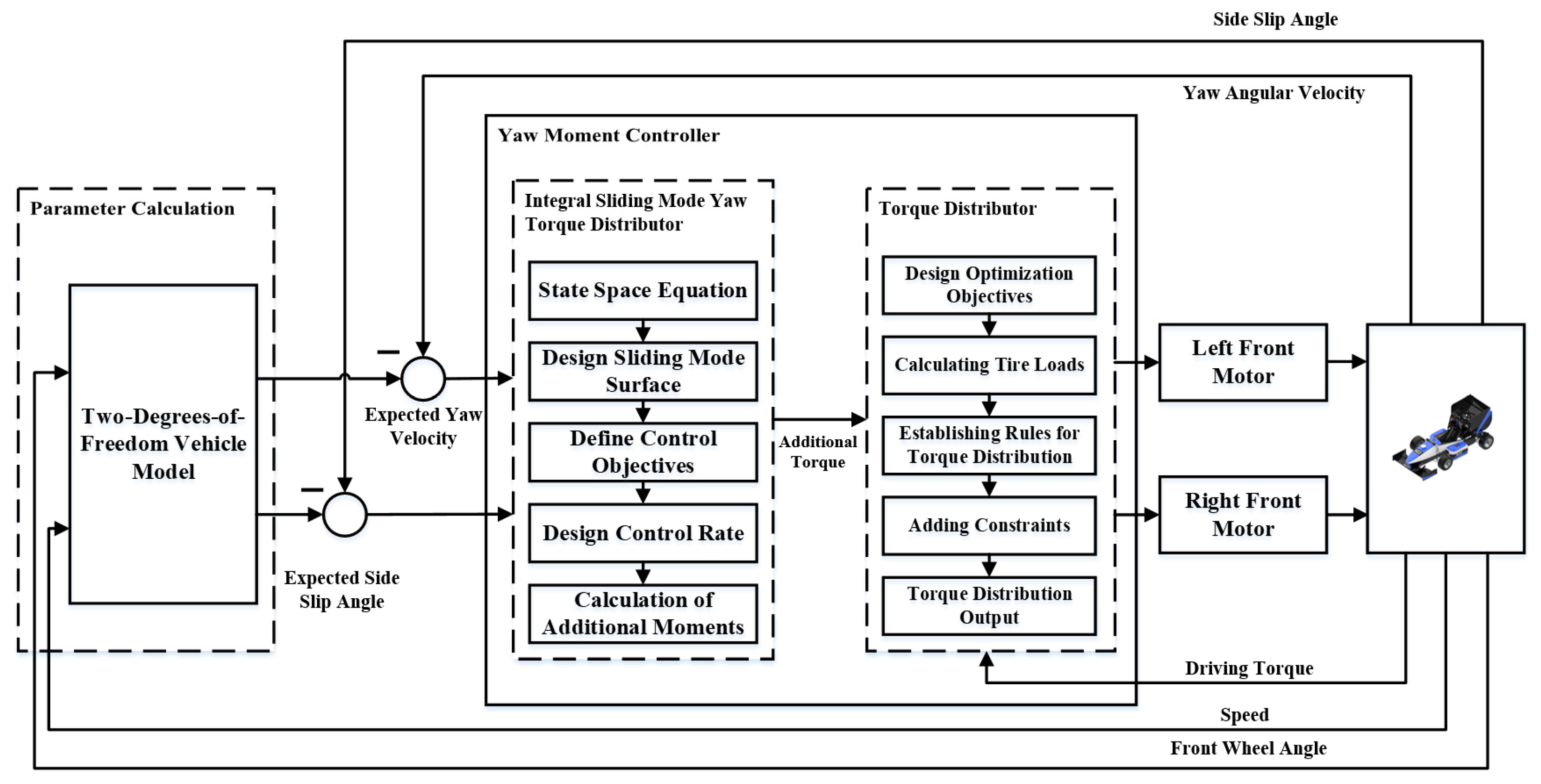
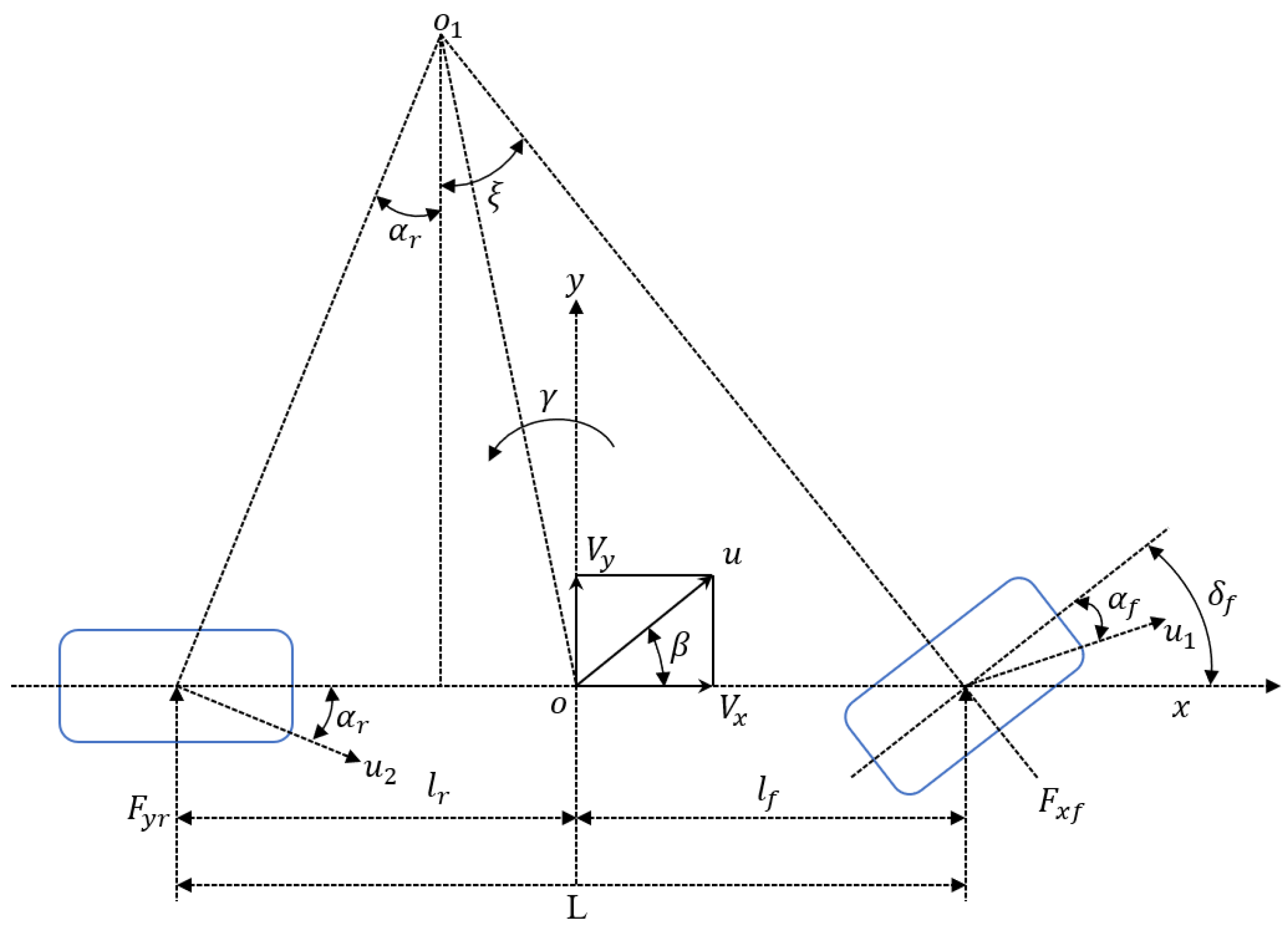

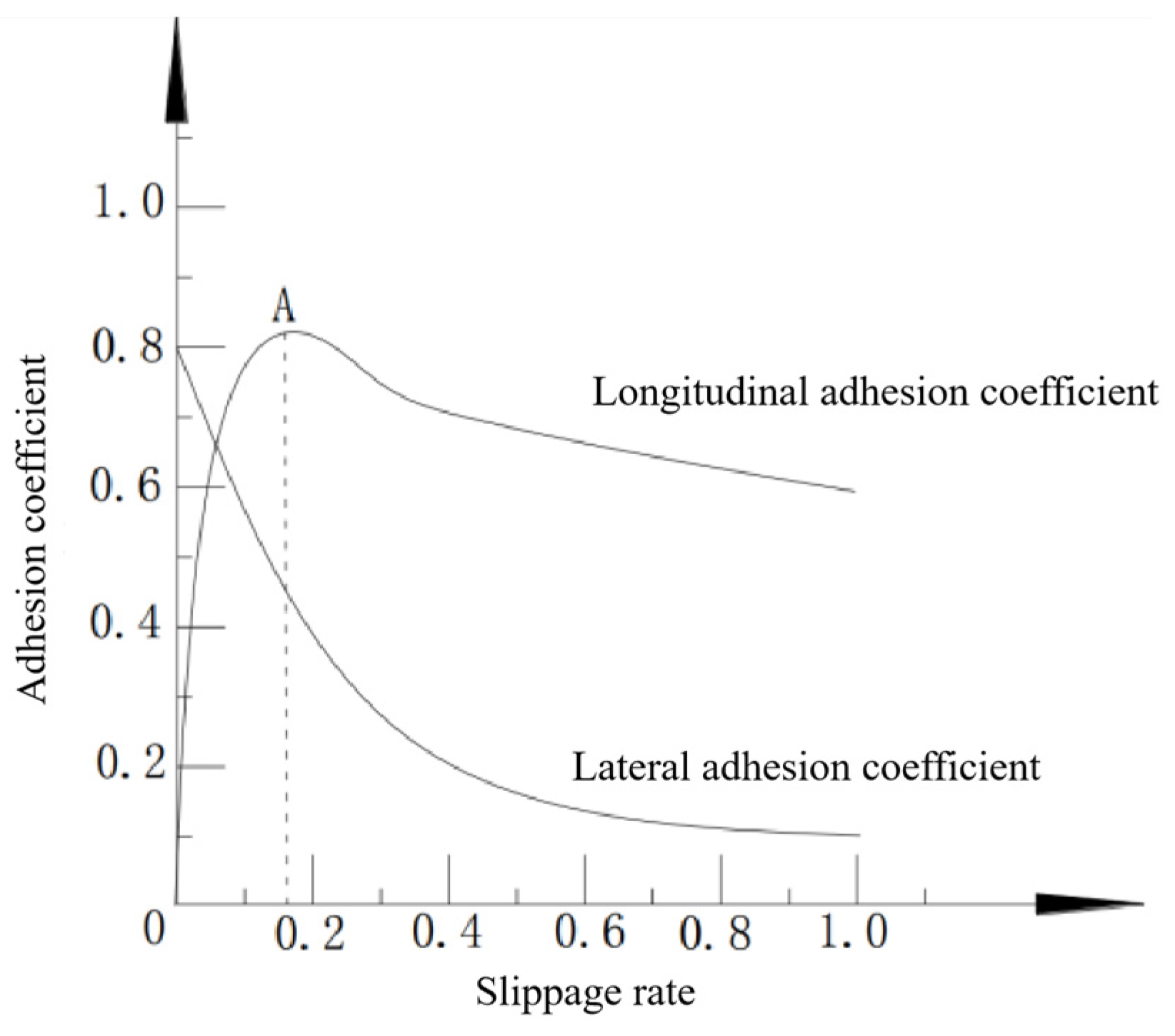
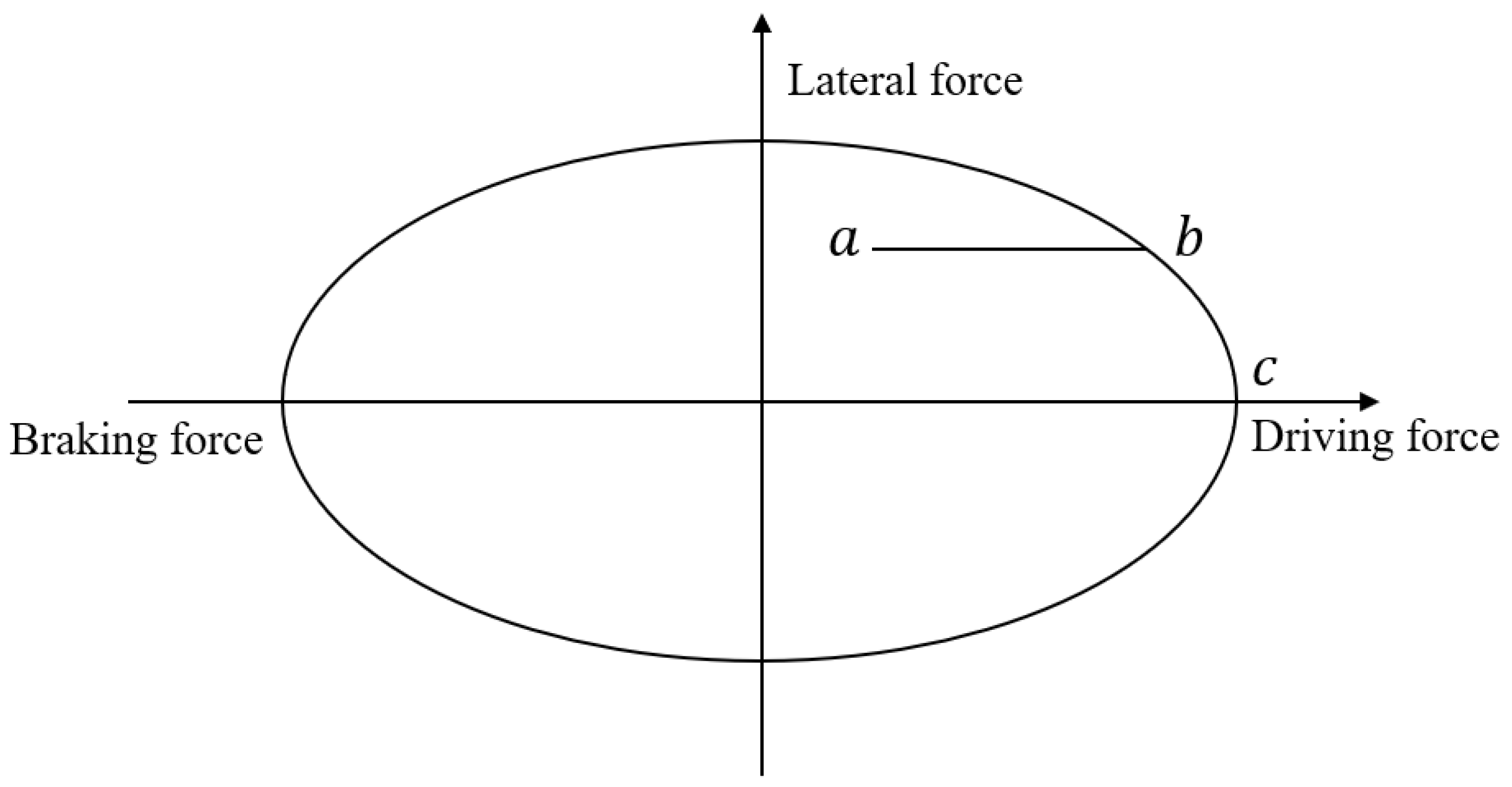

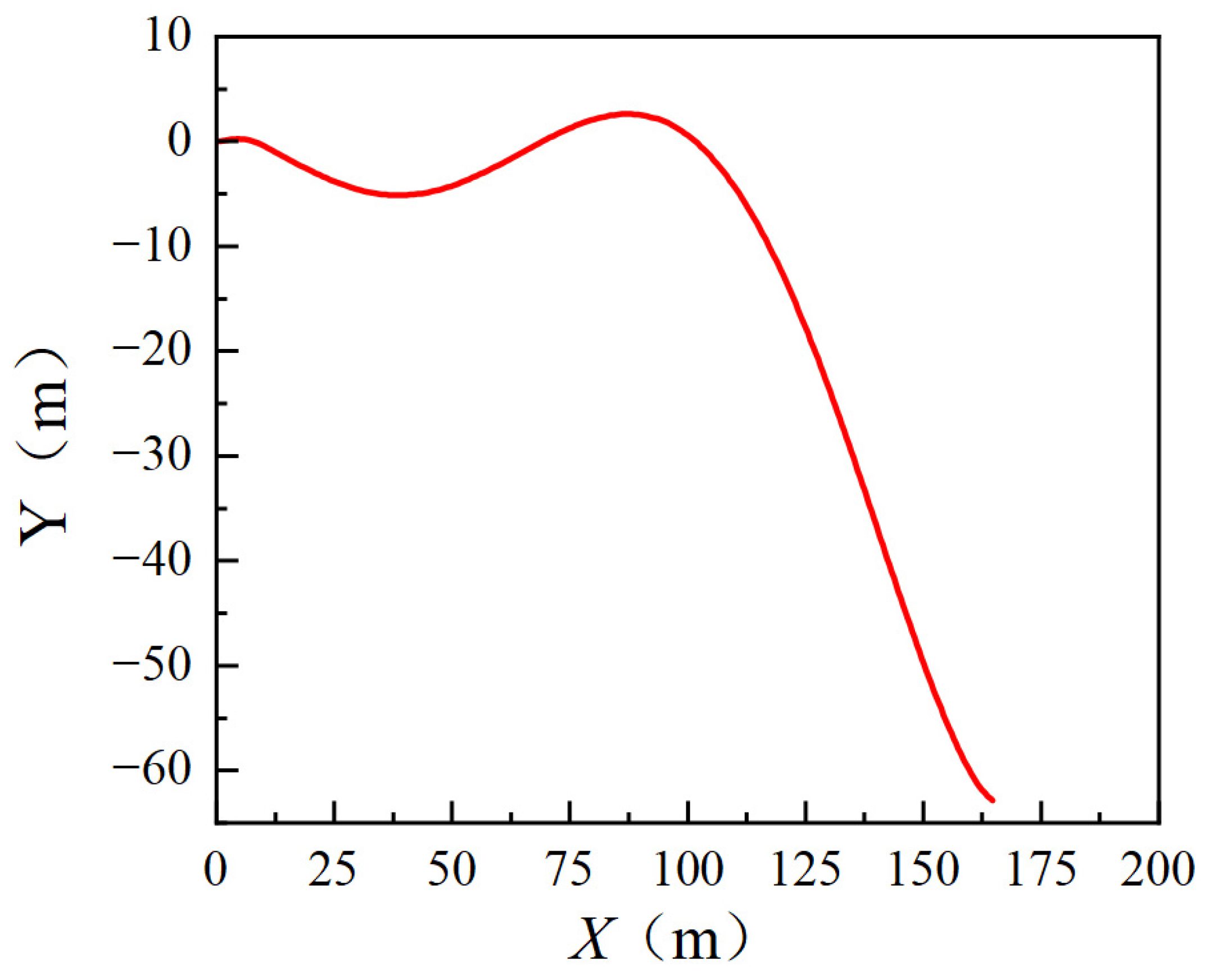

| Steering | Front-Wheel Steering Angle | Yaw Velocity Deviation | Additional Yaw Moment | Steering Characteristic | Torque Distribution |
|---|---|---|---|---|---|
| Left turn | Oversteer | ||||
| Left turn | Understeer | ||||
| Right turn | Understeer | ||||
| Right turn | Oversteer |
| Symbol | Definition | Value |
|---|---|---|
| m | Vehicle mass | 260 kg |
| a | Distance of CG from front axle | 760.5 mm |
| b | Distance of CG from rear axle | 852.5 mm |
| c | Wheelbase | 1210 mm |
| l | Axle base | 1550 mm |
| h | Height of CG | 300 mm |
| Iz | Vehicle yaw moment of inertia | 1325 kg/m2 |
| J | Wheel yaw moment of inertia | 0.9 kg/m2 |
Disclaimer/Publisher’s Note: The statements, opinions and data contained in all publications are solely those of the individual author(s) and contributor(s) and not of MDPI and/or the editor(s). MDPI and/or the editor(s) disclaim responsibility for any injury to people or property resulting from any ideas, methods, instructions or products referred to in the content. |
© 2024 by the authors. Licensee MDPI, Basel, Switzerland. This article is an open access article distributed under the terms and conditions of the Creative Commons Attribution (CC BY) license (https://creativecommons.org/licenses/by/4.0/).
Share and Cite
Liu, B.; Li, G.; Bai, H.; Wang, S.; Zhang, X. Research on Yaw Stability Control of Front-Wheel Dual-Motor-Driven Driverless Formula Racing Car. World Electr. Veh. J. 2024, 15, 178. https://doi.org/10.3390/wevj15050178
Liu B, Li G, Bai H, Wang S, Zhang X. Research on Yaw Stability Control of Front-Wheel Dual-Motor-Driven Driverless Formula Racing Car. World Electric Vehicle Journal. 2024; 15(5):178. https://doi.org/10.3390/wevj15050178
Chicago/Turabian StyleLiu, Boju, Gang Li, Hongfei Bai, Shuang Wang, and Xing Zhang. 2024. "Research on Yaw Stability Control of Front-Wheel Dual-Motor-Driven Driverless Formula Racing Car" World Electric Vehicle Journal 15, no. 5: 178. https://doi.org/10.3390/wevj15050178






